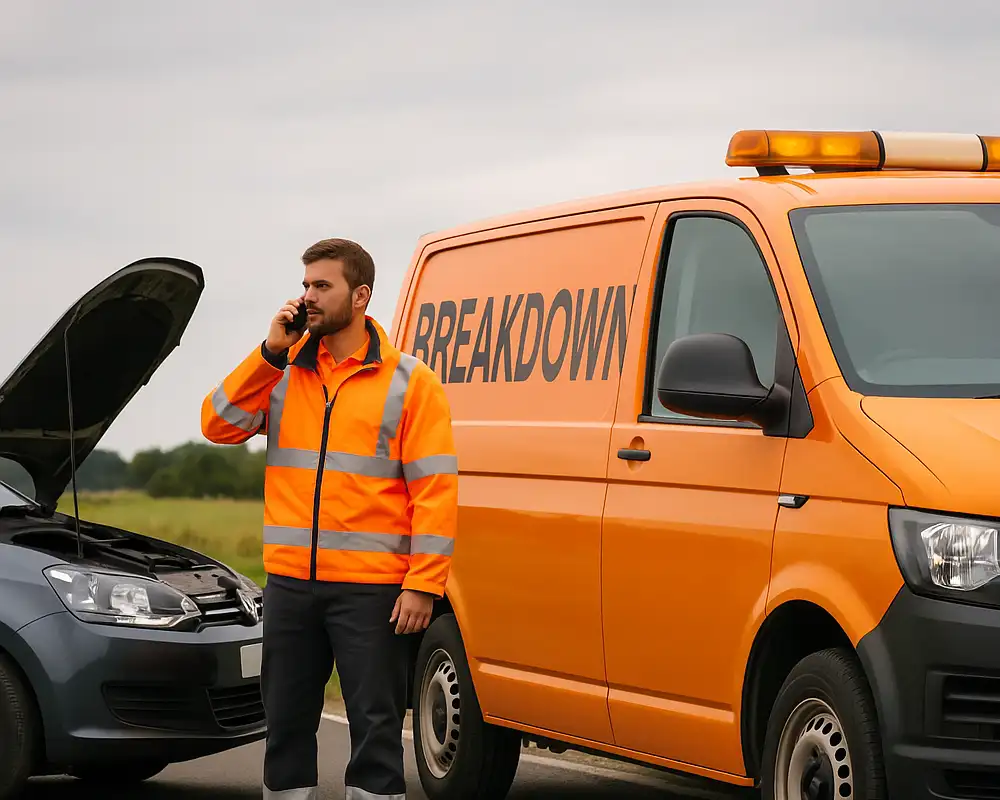Breakdown Cover Explained: A Complete UK Guide for Learner Drivers
We explain what you need to know about taking out breakdown cover
Getting your driving licence is exciting, but there’s more to safe driving than just passing your test. One question many new drivers ask is:
What is breakdown cover, and do I really need it?
This guide explains breakdown cover in clear, simple terms—what it is, how it works, and how to choose the right level of protection for you.
What is Breakdown Cover?
Breakdown cover is a service that helps you if your car stops working unexpectedly.
It means you can call for help if your vehicle:
- Won’t start
- Breaks down on the road
- Has a flat tyre or dead battery
- Has other mechanical or electrical faults
A professional mechanic (a patrol) will try to fix your car at the roadside. If it can’t be fixed there, they’ll tow you to a garage or even your home, depending on your cover level.
In short: it’s peace of mind that you won’t be left stranded.

Why is Breakdown Cover Important.
Breakdowns can happen to anyone—even with a new car.
Benefits include:
✅ No being stuck alone at night or in bad weather.
✅ Avoiding expensive towing fees.
✅ Less stress, especially for new drivers.
✅ Quick professional help when you need it.
For learner drivers or those newly on the road, breakdown cover is an affordable safety net.
How Does Breakdown Cover Work?
Here’s how it usually works:
- Your car breaks down.
- You call your breakdown provider.
- They send a patrol to help you.
- The mechanic tries to fix it at the roadside.
- If it can’t be fixed, they tow you somewhere safe (a garage, your home, etc.).
This saves you from having to arrange your own tow or pay high fees on the spot.
Types of Breakdown Cover
Breakdown cover isn’t one-size-fits-all. You can choose the right level of cover for your needs.
Roadside Assistance
- The most basic option.
- Covers breakdowns away from home (usually over ¼ mile).
- Tows you to a nearby garage if needed (limits apply, e.g. 10 miles).
- Best for local driving on a budget.
At-Home Cover (Home Start)
- Covers you at home or within ¼ mile.
Ideal if your car won’t start in your driveway. - Especially helpful for flat batteries in cold weather.
National Recovery
- Lets you choose anywhere in the UK for towing.
- Perfect for long trips or family visits.
- Avoids being stranded far from home.
Onward Travel
- Covers extra costs if your car can’t be fixed quickly.
- Hire car, taxi, train tickets, or hotel accommodation.
- Great for holidays or essential journeys.
European Breakdown Cover
- Extends your cover to Europe.
- Includes roadside help, towing abroad, and sometimes repatriation.
- Essential for driving holidays.
Personal vs Vehicle Cover
Breakdown cover also lets you choose who or what you want to protect.
Personal Cover
✅ Covers you as a driver or passenger in any eligible car.
✅ Perfect if you use different cars or drive family/friends’ cars.
✅ Can cover up to 5 household members on some plans.
Vehicle Cover
✅ Covers one specific car, no matter who’s driving.
✅ Ideal for single-car households.
✅ Usually cheaper than personal cover.
Optional Extras for Breakdown Cover
- Many providers let you customise your plan with extras:
- Key Replace – Lost or stolen keys (often up to £1,500).
- Battery Replace – Starter battery replacement included.
- Tyre Replace – Covers up to 5 new tyres a year.
- Misfuelling Cover – Helps if you put the wrong fuel in.
These cost more but can save money in emergencies.
How Much Does Breakdown Cover Cost?
Typical costs (as of 2025):
- Basic Roadside Cover: ~£5–£7/month
- Personal Cover: ~£7–£9/month
- National Recovery: ~£9–£12/month
- Full Packages: ~£12–£20/month
- European Cover: ~£60–£150/year
Annual payments are usually cheaper than monthly.
How Fast is Help?
Top UK providers offer:
- Average 60-minute response times.
- Around 80% of breakdowns fixed at the roadside.
- Large national networks.
Check your chosen provider’s stats—they make a big difference.
What’s Not Usually Covered?
Breakdown cover helps with mechanical and electrical issues, but usually excludes:
❌ Accidents (use your car insurance instead)
❌ Routine servicing or wear-and-tear repairs
❌ Fuel top-ups (unless you have misfuelling cover)
❌ Vehicles without MOT, tax, or insurance
❌ Repeated callouts for the same unfixed fault
Always read the policy details carefully.
Is Breakdown Cover Worth It?
✅ For most drivers, yes—especially learners and new drivers.
It’s not required by law, but offers:
- Affordable protection against big bills.
- Safety and peace of mind.
- Help anytime, anywhere in the UK.
- Confidence for long trips or unfamiliar routes.
Even new cars can break down. One tow can cost more than a year’s cover.
Frequently Asked Questions
Do learner drivers need breakdown cover?
Not legally—but it’s strongly recommended if you own or drive a car independently. Parents often buy it for their children’s first car.
Can I get breakdown cover for driving lessons?
Usually not needed—driving instructors have cover for their tuition car.
Can I get cover for more than one person?
Yes! Look for personal or family cover plans that include multiple drivers in one household.
How do I choose the right level?
Consider:
- How far you drive.
- How old your car is.
- Your budget.
- How much peace of mind you want.
Basic roadside help is a good start; you can always upgrade.
Final Thoughts
Breakdown cover is one of the easiest ways to protect yourself as a driver.
Whether you’re a brand-new learner or building confidence after your test, it ensures that whatever happens, help is just a phone call away.
At Andrew’s Driving School, we’re always happy to give advice on choosing the best cover—just ask!
My experience
Some years ago I was driving back to Wales from Manchester when the cam belt snapped on my car, probably due to lack of maintenance but hey these things do happen. Stuck on the hard shoulder of the M56 I was left with no choice but to call out the emergency breakdown, the AA arrived, now as I wasn’t a member I had to pay a joining fee, and also as I hadn’t been a member for 24 hours before the breakdown I was charged for towing my vehicle back home, I was then handed a bill for the full cost of recovery which came to over £1000. If I had the breakdown cover in place, I would have been recovered at no cost.
